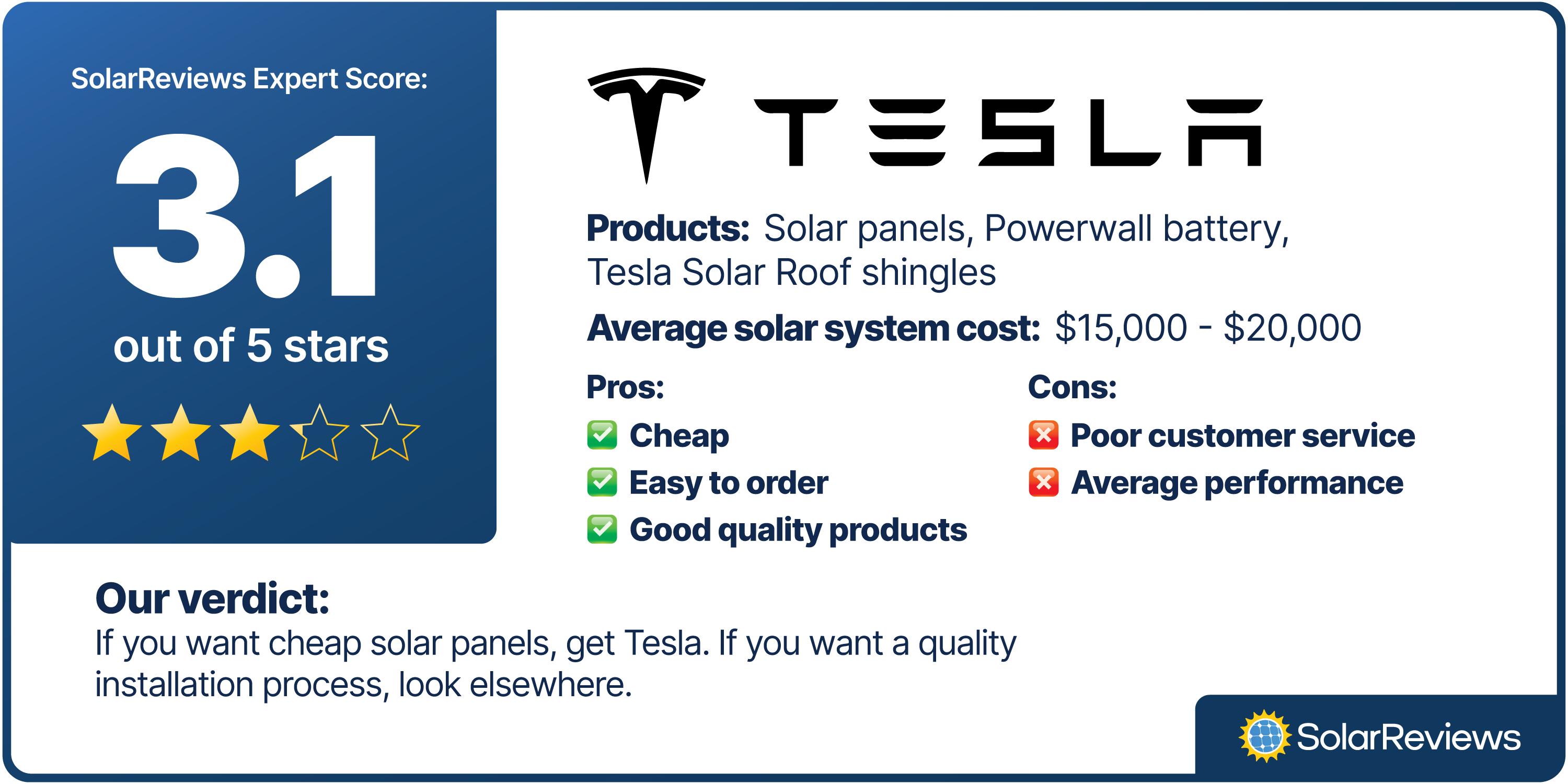
Pros and cons of going solar with Tesla
Pros
-
Can be cheaper than other installers
-
Easy to order
-
Good products
-
Sleek design
Cons
-
Poor customer service
-
Average product performance
-
Difficult to find product information
How much does going solar with Tesla cost?
Tesla solar panels | Tesla Solar Roof | Tesla Powerwall |
|---|---|---|
$20,160 | $100,000+ | $16,000 |
*Estimated cost of Tesla solar installations before incentives for an average home
Tesla’s solar panels
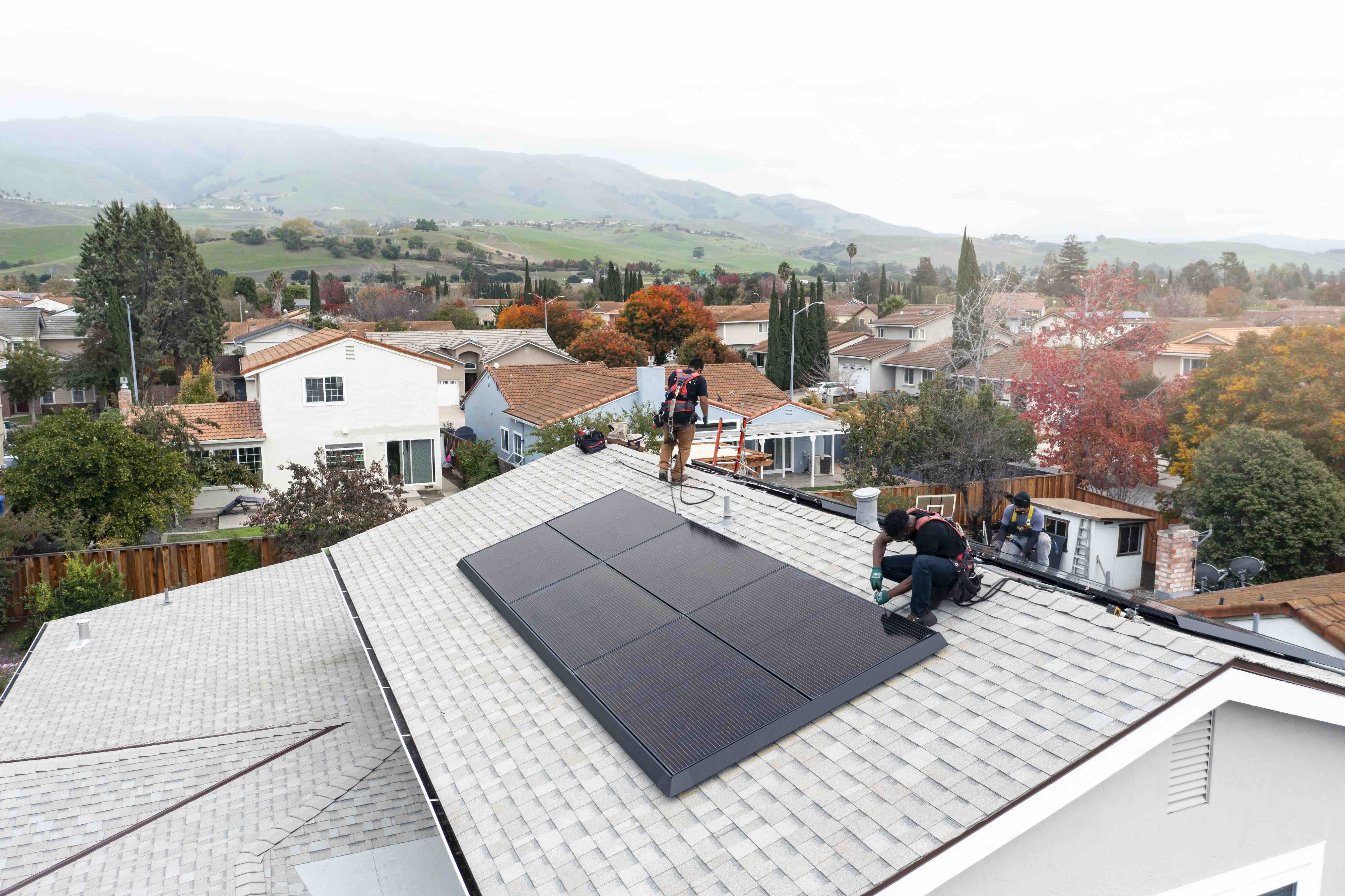
Image courtesy of Tesla, Inc.
Tesla solar panels cost about $2.80 per watt before incentives or about $20,160 for a 7.2 kilowatt (kW) installation. After the federal tax credit, the total cost of a Tesla solar panel system averages $14,112. Local rebates and solar incentives can reduce the cost even further.
With the average cost of solar panels in the U.S. sitting at about $3.01 per watt, Tesla installations tend to be a bit cheaper. However, we did get multiple estimates through Tesla’s website, and the prices in some areas were around $3.09 per watt.
Powerwall battery
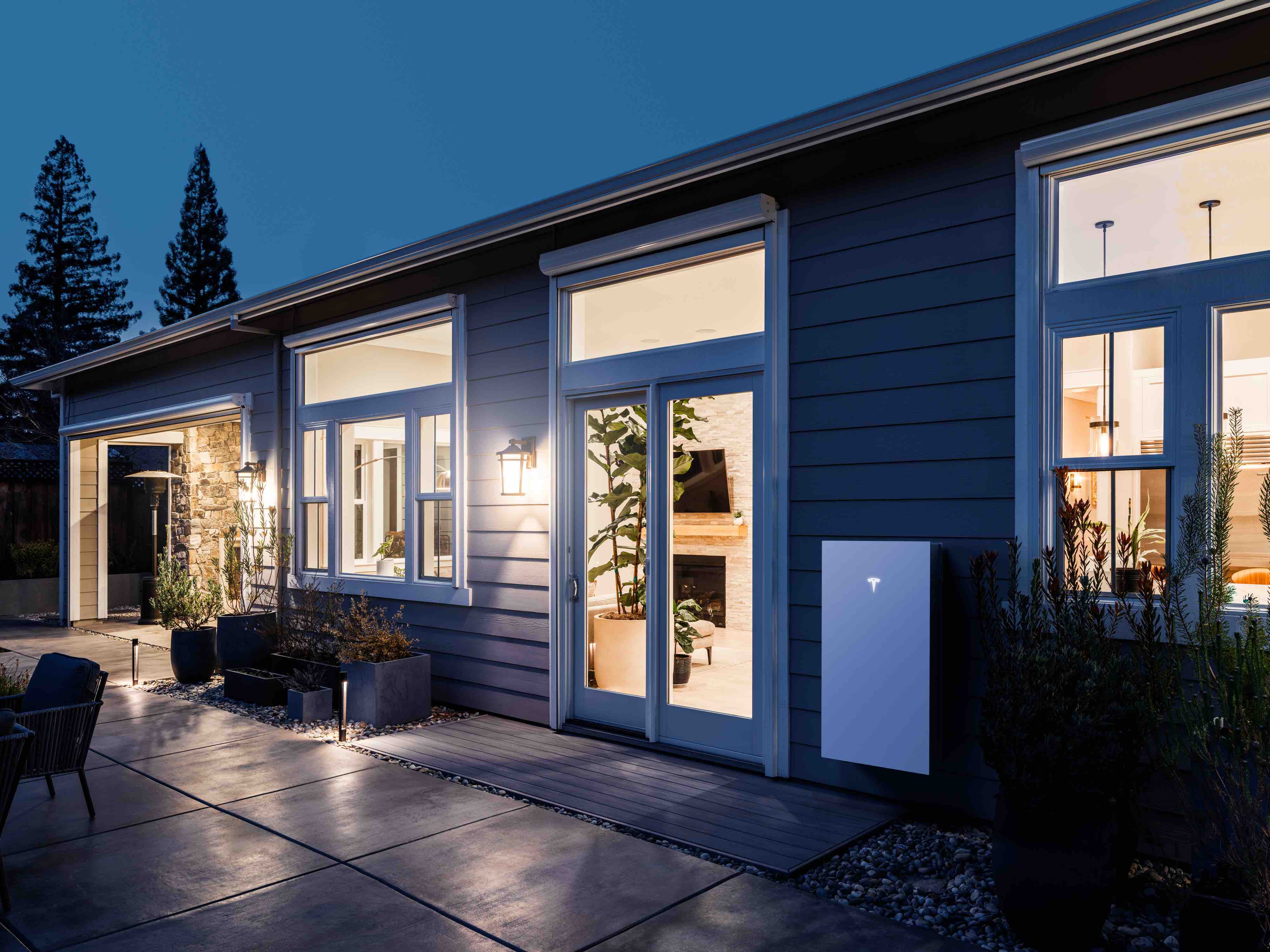
Image courtesy of Tesla, Inc.
In some areas, Tesla requires its solar panels to be paired with a Powerwall battery, which drives up the total installation price. The new Powerwall 3 costs about $16,000, but depending on where you live, some quotes are a little higher or a little lower.
The Powerwall battery system solar energy you generate during the day, so you can use it when your panels aren’t producing energy or during a power outage.
While $16,000 is a lot of money, that’s considered a great price for a home solar battery storage system.
Luxury Solar Roof
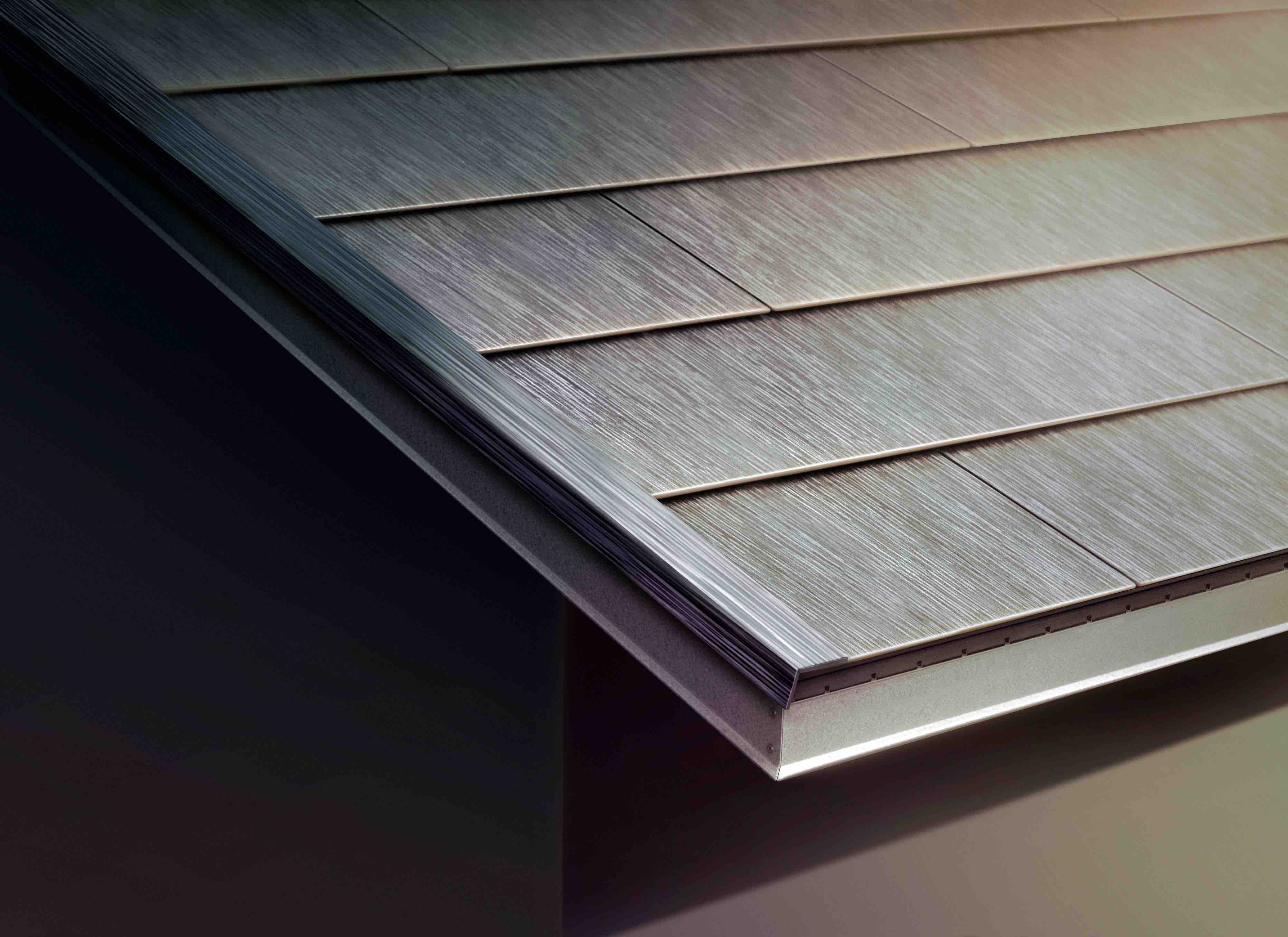
Image courtesy of Tesla, Inc.
The Tesla Solar Roof is the company’s home solar option that requires you to get a total roof replacement using Tesla’s solar-generating shingles. Coming in at over $100,000 per installation, the Tesla Solar Roof is definitely a luxury purchase.
Most homeowners will be better off getting traditional solar panels. But for those who want to splurge on a clean energy system, Tesla solar shingles might be the best option. Like Tesla’s other energy offerings, the exact cost of a Tesla Solar Roof will vary by where you live.
Are Tesla solar panels still cheap? Tesla used to be the lowest price option in the home solar industry, averaging solar panel installation prices of around $2.50 per watt. However, it seems like Tesla’s prices are increasing and falling more in line with what other installers offer. There are still plenty of locations where Tesla’s prices are hard to beat, but generally, its price ranges are well within the average cost of solar in certain states.
Are Tesla’s solar panels worth the price?
You can get a Tesla solar power installation for a reasonable price, but that doesn’t mean you should jump right into a contract. Although many people think “Tesla” is synonymous with “luxury”, when it comes to solar panels, Tesla’s are pretty average.
Plus, Tesla loses major points with us because of its poor customer service reputation, which is one of the key factors you need to consider when making a 25-year investment like solar!
Let’s take a closer look at whether Tesla solar is worth the slightly lower price.
Tesla solar panel performance and technology
Installed cost per watt | Panel wattage | Efficiency | Dimensions | Product warranty | Performance warranty | |
|---|---|---|---|---|---|---|
Industry average | $3.00 per watt | 400 - 430 W | 21% | 65” x 39” | 12 year | 25-year, 0.50% annual degradation rate |
Tesla solar panels | $2.80 per watt | 395 - 430 W | 19.3% - 20.6% | 74.4” x 41.2” | 25 years | 25-year, 0.54% annual degradation rate |
Tesla’s solar panels are nothing special from a performance perspective. They’re just as powerful as other panels on the market, and in fact, they tend to be a little less efficient than competitors. They’re also larger than other solar panels, which is why Tesla solar panels can produce the same amount of energy as other brands with lower efficiency ratings.
All in all, Tesla panels are good, they just aren’t anything to write home about. They perform well, they’ll meet your energy needs, and they look good, but you can get panels that outperform Tesla’s from a local solar installer without paying that much more.
Tesla solar panel warranty
Warranty type | Product warranty | Performance warranty |
|---|---|---|
Industry average | 12 year | 25-year, 0.50% annual degradation rate |
Tesla solar panels | 25 year | 25-year, 0.54% annual degradation rate |
Most panels come with two kinds of solar warranties: a product warranty and a performance warranty.
A product warranty protects you from any damages the panels may have gotten during the manufacturing. The industry average for product warranties is at least 12 years, with many brands moving up to 15 or 25-year warranties. Tesla has a 25-year warranty, so you’ll be protected for longer than other brands!
A solar panel’s performance warranty outlines how well the panels will perform as they age. Almost all solar panels on the market today come with a 25-year performance warranty and degrade at a rate of about 0.50% per year. The best solar panels on the market degrade slower, with a degradation rate closer to 0.25% annually.
Tesla’s performance warranty term aligns with industry standards, but the panels themselves degrade just a bit quicker than competitors. This isn’t a make-it-or-break-it type of thing, but it is something to consider - you can definitely find longer-lasting panels that will have higher energy production levels of their lifetime.
Tesla solar panel customer service
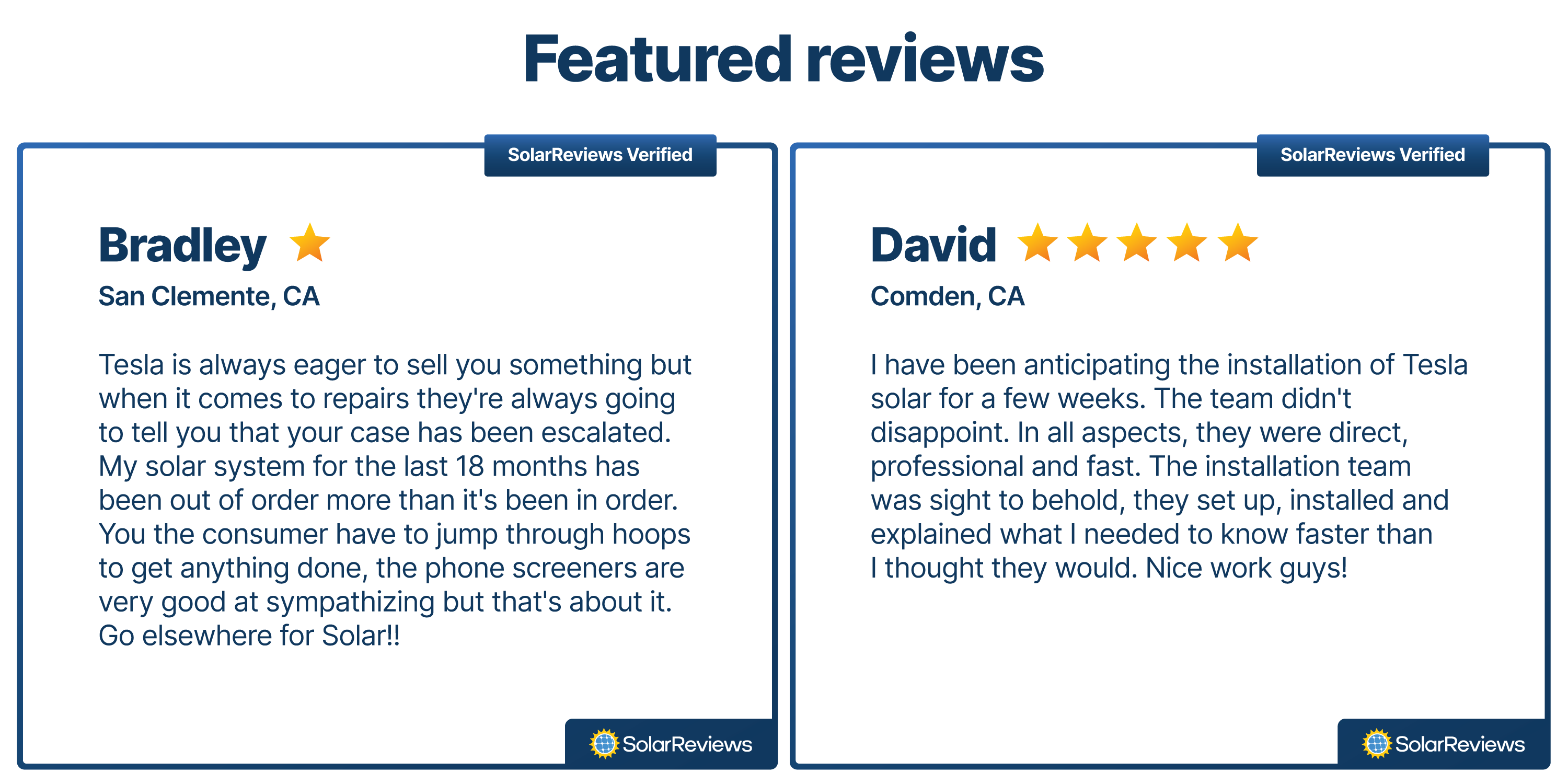
It’s true that Tesla will probably be one of the cheapest solar quotes you get when choosing a solar company. But the price of solar also includes the cost of the long-term relationship you get with your solar installer, which seems to be where Tesla cuts costs.
Tesla has over 800 customer reviews here on SolarReviews, with an average score of just 2.61 stars. Most of the negative feedback highlights that Tesla provides very little communication before installation begins and customers have found it difficult to get a response if something goes wrong with their system after installation. The longer you wait for Tesla to answer, the more money you potentially lose.
It’s not always a bad experience. Some homeowners have reported stellar installations through Tesla and are very satisfied with their systems. But, we will say many of the positive reviews on our site highlight the installation crews, not the experience with Tesla representatives.
This is the kind of variation you can get with a large company like Tesla, but it’s up to you if it’s worth the risk. You can read real customer reviews about going solar with Tesla right here on SolarReviews.
Tesla solar system add-ons and features
Tesla solar installations have other benefits besides affordable solar panels or a great battery. Some other benefits of Tesla solar include:
System monitoring: Tesla has one of the best solar monitoring interfaces in the game. Your solar production, usage, and battery status can be checked right from your phone in the Tesla app. It’s easy to use and understand.
Tesla’s inverter: Tesla’s solar inverter is great! With four maximum power point trackers, the single inverter can be used for even the most complex system designs. It also has a similar design to the Powerwall, so it looks sleek compared to other string inverters.
System components from one company: When you go solar with Tesla, all your equipment comes from one company. This means you only deal with one place for all of your future warranty needs instead of figuring out who to call for each piece of your system.
Financing options: Tesla has its own financing options to help with upfront solar and energy storage installation costs. Tesla’s solar loans have pretty standard interest rates, but they don’t include dealer fees, which can save you a lot of money on the principal of the loan.
Final verdict: Is Tesla solar right for you?
Overall, if your only concern is getting cheap solar, Tesla Energy could be right for you. Tesla sells solar panels at a lower price than many installation companies because it doesn’t have to worry about customer acquisition costs.
But we urge you to consider more than just the price when shopping for solar panels. Tesla’s solar panels look nice thanks to proprietary racking that makes them more discrete against your roof, but they’re average at best regarding performance. It’s also nearly impossible to find a complete spec sheet for Tesla’s solar panels and Solar Roof tiles, making it hard to judge just how worth it they are.
But, the biggest thing that would take Tesla off of our list of installers is its customer service reputation. Anecdotes from customers across the internet show that Tesla doesn’t support its customers. Whether in the lead-up to the installation or after it’s completed, Tesla seems to leave homeowners hanging.
With an investment that will last for 25 years or more, that’s a huge red flag. You should want top-quality equipment from an installer that provides best-in-show support. It may cost a little more, but it will be worth it in the long run. We recommend getting quotes from at least a few local solar companies. Local companies tend to have higher customer satisfaction, might have better-performing products, and are usually there to help you every step of the way.
Methodology
We rated Tesla by looking at four factors: customer satisfaction, quality of products, availability, company profitability, and price. We believe these criteria cover some of the most important things a homeowner should consider when looking at a large, national solar brand like Tesla.
When scoring the quality, value, and availability of Tesla Energy products, Tesla solar panels and the Powerwall battery were weighted higher than the Solar Roof because it’s a luxury product that hasn’t quite hit widespread popularity yet.
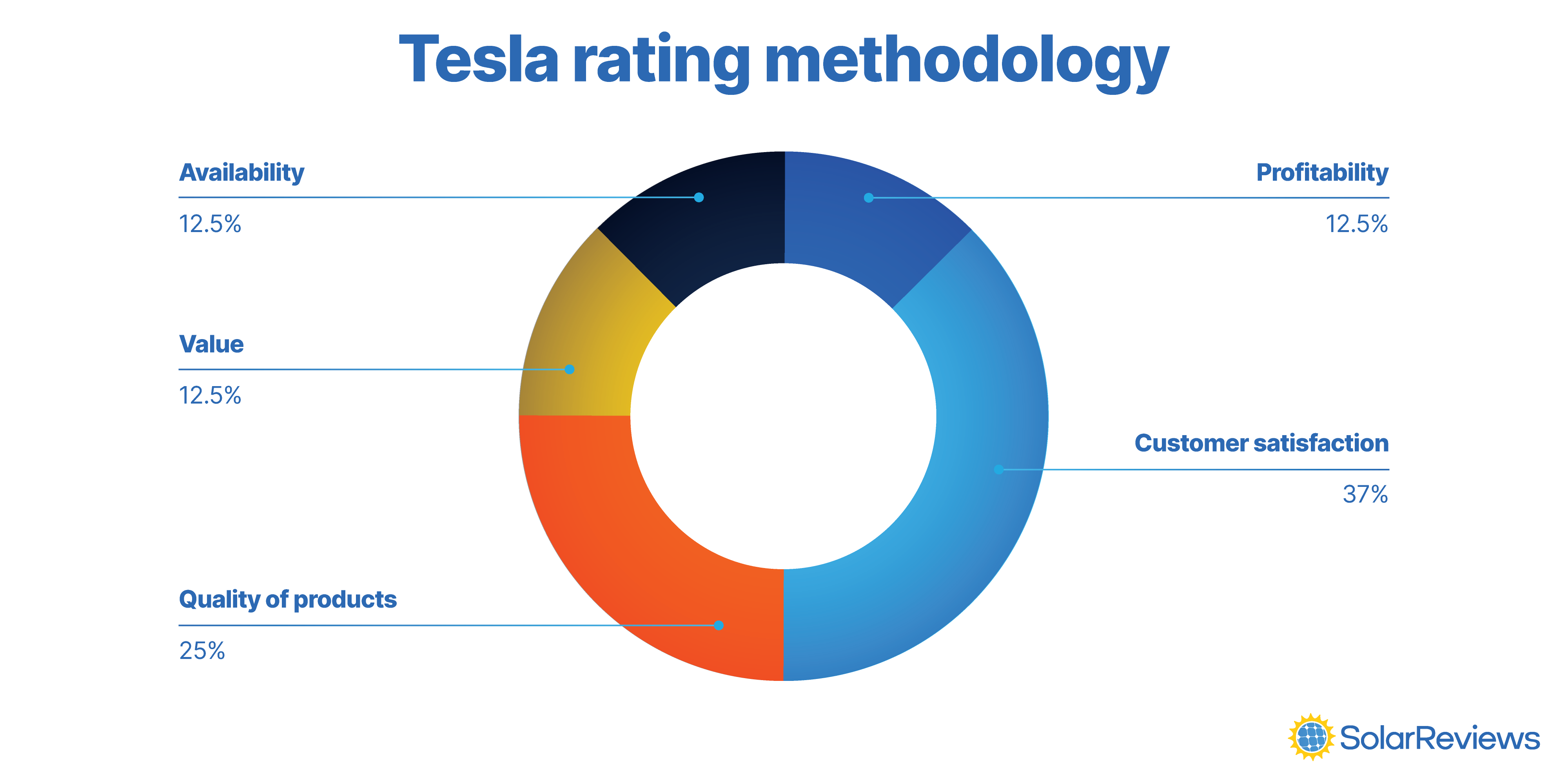
Catherine has been researching and reporting on the solar industry for five years and is the Written Content Manager at SolarReviews. She leads a dynamic team in producing informative and engaging content on residential solar to help homeowners make informed decisions about investing in solar panels. Catherine’s expertise has garnered attention from leading industry publications, with her work being featured in Solar Today Magazine and Solar ...
Learn more about Catherine Lane